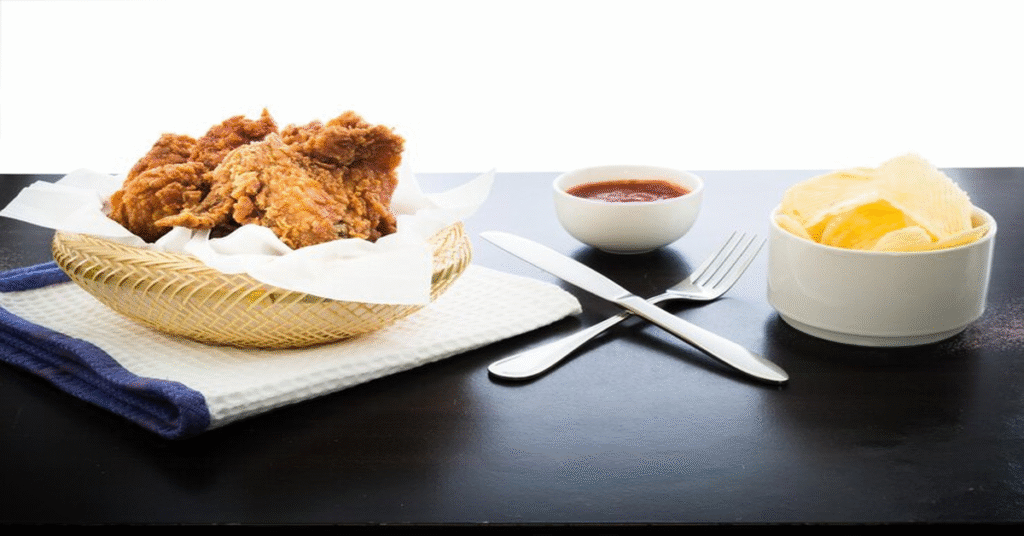In the bustling streets of many urban neighborhoods across the northeastern United States, a familiar red, white, and blue sign flashes its way into local food culture. Often nestled between bodegas, barbershops, and corner stores, Kennedy Fried Chicken locations are as ubiquitous in some communities as Starbucks is in others. With its hearty fried chicken, late-night hours, and accessible price points, Kennedy Fried Chicken has quietly cemented itself as a staple in the urban culinary landscape.
But what is Kennedy Fried Chicken’s, really? Is it a chain? A franchise? A tribute to a former president? The answers are not as straightforward as you might expect. This article explores the origins, structure, menu, business dynamics, and cultural footprint of this uniquely American fried chicken phenomenon.
The Origins of Kennedy Fried Chicken
Humble Beginnings
Kennedy Fried Chicken emerged in the 1970s and 1980s, primarily in New York City. It was not the product of a single corporate vision but rather the brainchild of independent entrepreneurs, often immigrants, looking to establish small food businesses that could serve the local community.
Unlike brands such as KFC or Popeyes, which were backed by large corporations, Kennedy Fried Chicken developed through a network of individually owned and operated stores that used a common name and branding for recognition and marketing appeal.
Why the Name “Kennedy”?
The name “Kennedy” is believed to be a reference to President John F. Kennedy, a figure widely admired across communities for his charisma and legacy. By choosing the name, early store owners hoped to evoke a sense of trust, American identity, and quality. The choice of red, white, and blue colors further emphasized the American patriotic theme.
Not a Franchise, But a Brand Style
The Independent Ownership Model
Unlike traditional franchises that operate under a centralized system with licensing, training, and royalties, Kennedy Fried Chicken’s follows a non-franchise model. Individual store owners operate independently but often:
- Use a similar name (Kennedy, Crown, or Royal Fried Chicken)
- Adopt familiar color schemes and signage
- Sell similar menu items
There is no official parent company or corporate oversight. This loose structure allows owners to maintain flexibility in pricing, ingredients, and operations.
Common Confusion with Other “Fried Chicken” Brands
Because of the similarities in name and appearance, Kennedy Fried Chicken’s is often confused with Crown Fried Chicken, another regional brand with a similar backstory. In fact, many stores use both names interchangeably or together.
This overlapping identity is part of the charm—and mystery—of these chicken spots. They’re part of a shared culinary subculture more than a clearly defined corporation.
The Menu: A Diverse Offering Beyond Chicken
Core Offerings
As the name suggests, fried chicken is the star of the menu. Most Kennedy Fried Chicken locations serve:
- Fried chicken pieces (drumsticks, thighs, breasts, wings)
- Chicken sandwiches
- Chicken tenders and nuggets
- Buffalo wings with sauces
Variety for Every Palate
One hallmark of Kennedy Fried Chicken’s is its extensive and diverse menu, often rivaling that of full-scale diners. In addition to fried chicken, you may find:
- Cheeseburgers and gyros
- Philly cheesesteaks
- Fish sandwiches
- Shrimp baskets
- Rice and beans
- Pizza slices (in some locations)
- Halal-certified meats
Many locations cater to local tastes and dietary preferences, including offering Halal options, vegetarian sides, and breakfast sandwiches.
Affordable and Filling
The food is known for being:
- Affordable: Combo meals are often priced under $10
- Filling: Generous portions, ideal for late-night cravings
- Accessible: Many locations stay open late or even 24/7
Community Impact and Cultural Relevance
A Neighborhood Staple
Kennedy Fried Chicken’s shops are often deeply embedded in local neighborhoods, especially in underserved areas with limited access to major chain restaurants. They serve as:
- Late-night food stops
- Gathering spots for teens and young adults
- Quick meals for commuters and shift workers
An Entrepreneurial Gateway
Many Kennedy Fried Chicken’s owners are first-generation immigrants, especially from Middle Eastern, South Asian, and African backgrounds. These restaurants serve as stepping stones into American small business ownership, providing:
- Economic mobility
- Family employment opportunities
- Community engagement
They are symbols of hard work, resilience, and self-started success.
Business Strategy and Operational Flexibility
Low Startup Barriers
Because there’s no formal franchise fee or corporate approval process, entrepreneurs can start a Kennedy Fried Chicken’s relatively affordably compared to branded chains. Common costs include:
- Leasing retail space
- Purchasing kitchen equipment
- Creating signage and menus
Vendor Freedom
Store owners often choose their own:
- Food suppliers
- Cooking oil and breading methods
- Marketing strategies
- Menu pricing
This operational independence allows each location to tailor its offerings to the specific demands of its neighborhood.
Challenges
Without centralized support, owners also face:
- High competition from similar shops
- Variability in quality
- Negative stigma or stereotyping
- Limited branding protection
But for many, the trade-off is worth the entrepreneurial autonomy.
Marketing and Brand Identity
Word-of-Mouth Over Big Campaigns
Kennedy Fried Chicken’s doesn’t rely on national ad campaigns. Its reach comes from:
- Street visibility
- Word-of-mouth referrals
- Consistency of the experience
The familiar storefront design acts like a non-verbal endorsement: you see the logo, you know what to expect.
Social Media and Memes
Over the years, Kennedy Fried Chicken has earned a cult following on:
- TikTok
- YouTube
- Local food blogs
Users share reviews, memes, and nostalgic posts—especially late at night or after parties. It’s become a cultural icon among younger generations.
Kennedy Fried Chicken vs. Fast Food Chains
Unique Selling Points
Compared to fast food giants, Kennedy Fried Chicken offers:
- Greater menu variety
- More culturally attuned service
- Lower prices for similar portion sizes
- A local, non-corporate feel
Quality Perception
While some may criticize inconsistencies, many patrons argue that:
- Chicken is cooked fresh
- Recipes are handed down through store owners
- Portions are more generous
- There’s a “homemade” touch missing from big brands
Regional Spread and Expansion
East Coast Dominance
Kennedy Fried Chicken locations are most common in:
- New York City
- New Jersey
- Pennsylvania
- Connecticut
- Massachusetts
Urban centers with large immigrant populations tend to have clusters of locations, sometimes within blocks of each other.
Slow, Organic Growth
Without a franchise model, expansion happens through word-of-mouth between entrepreneurs rather than corporate planning. A former employee might open their own store nearby, leading to organic, grassroots scaling.
Criticism and Controversies
Health Concerns
As with many fast-food outlets, concerns about:
- High sodium and fat content
- Portion sizes
- Lack of transparency in nutrition facts
Have sparked calls for healthier options and clearer labeling.
Stereotyping and Urban Bias
Some critics associate Kennedy Fried Chicken with:
- Crime-ridden neighborhoods
- “Greasy fast food culture”
- Urban blight
This perspective ignores the economic and cultural value these establishments provide and perpetuates unfair stigmas.
Future of Kennedy Fried Chicken
Modernization Opportunities
Some newer Kennedy Fried Chicken stores are:
- Upgrading interiors
- Offering online ordering and delivery
- Partnering with food delivery apps
These steps could help bridge the gap between local charm and modern convenience.
Branding Challenges
Because of the unregulated use of the name, the brand may struggle with:
- Trademark protections
- Quality consistency
- Public trust issues in new markets
Solutions could include:
- Voluntary cooperative branding
- Regional alliances among owners
- Community-led quality certification
Conclusion
Kennedy Fried Chicken is more than just a place to get a crispy drumstick—it’s a cultural institution, a small business success story, and a reflection of the diverse communities it serves. From its mysterious beginnings and decentralized structure to its status as a late-night culinary hero, Kennedy Fried Chicken holds a unique place in America’s urban foodscape.
What started as a humble takeout spot has grown into a beloved symbol of immigrant entrepreneurship, adaptability, and street-level dining satisfaction. For many, a visit to Kennedy Fried Chicken isn’t just about the food—it’s about nostalgia, community, and comfort.
As cities change and digital tools evolve, the Kennedy Fried Chicken model faces new opportunities and challenges. Yet, its legacy remains intact: affordable, flavorful meals served with heart and hustle on the corner of your block.
FAQs
1. Is Kennedy Fried Chicken a national chain?
No. Kennedy Fried Chicken is not a traditional chain or franchise. It’s a network of independently owned restaurants that use similar branding.
2. Are all Kennedy Fried Chicken locations the same?
No. Since each location is independently owned, menus, prices, and food quality can vary by store.
3. Where is Kennedy Fried Chicken most commonly found?
Kennedy Fried Chicken is most common in East Coast urban centers like New York City, Newark, Philadelphia, and Boston.
4. Does Kennedy Fried Chicken offer Halal food?
Many locations offer Halal-certified chicken, but it depends on the individual owner. Always ask to confirm.
5. Why is it called “Kennedy”?
The name likely pays tribute to President John F. Kennedy, symbolizing trust and American identity. It’s used to evoke patriotism and brand recognition.
6. Is Kennedy Fried Chicken a franchise I can join?
No formal franchise exists. However, entrepreneurs often model new restaurants after existing ones using similar names, menus, and branding.







